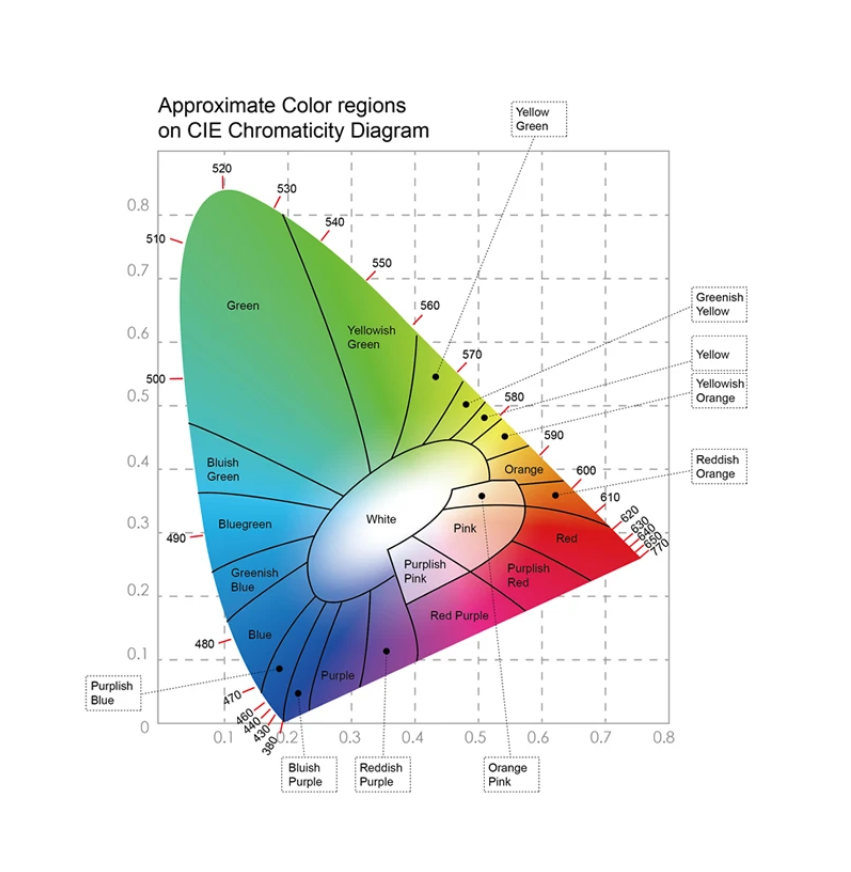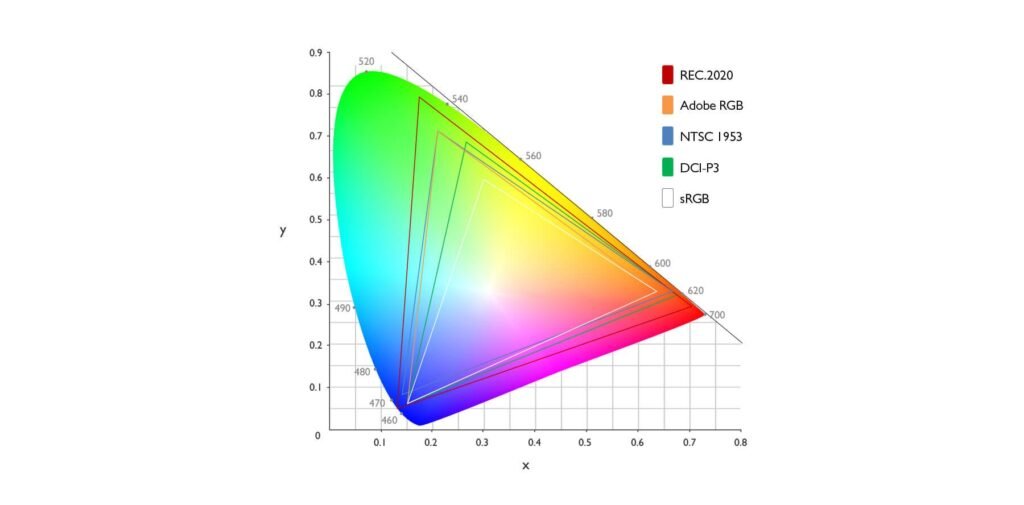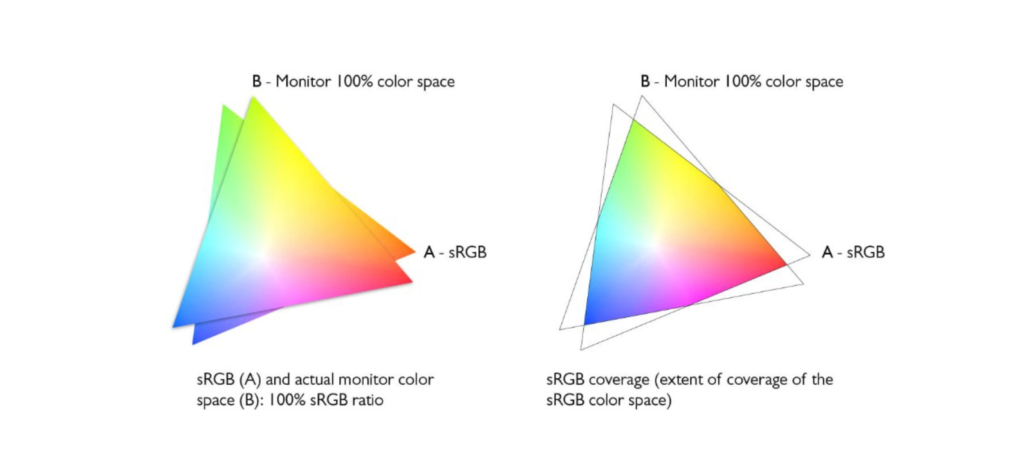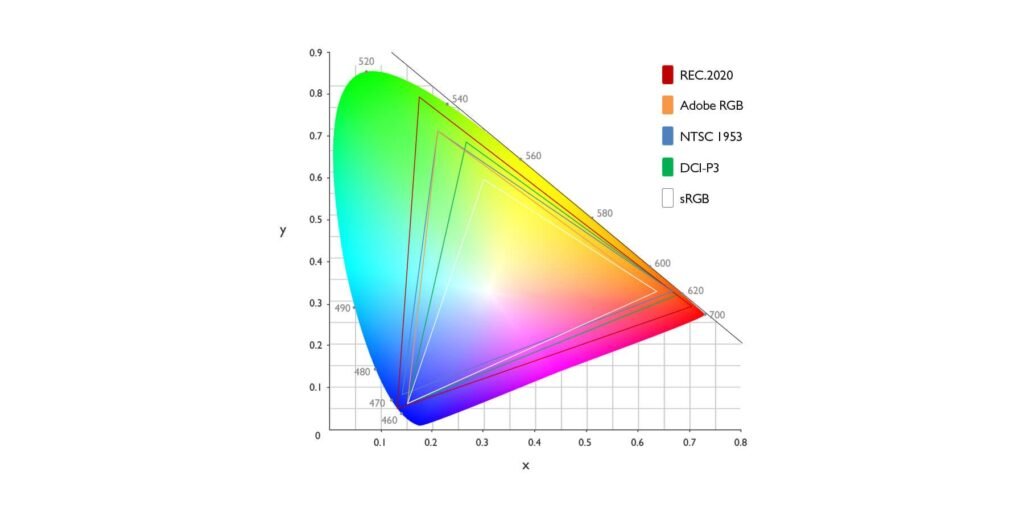The color gamut describes the range of colors within the spectrum that can be reproduced on an output device. Depending on how wide the gamut is, every screen will display different quantities and qualities of color. For example, most monitors can produce 16.7 million colors, but some can achieve much more (1.07 Billion colors).
Understanding Color Gamut
When shopping for a television or monitor, you likely notice the size and resolution, but the quality of the colors can be just as critical. Deep blacks, vibrant reds, lush greens—these all contribute to the immersive experience of modern displays. This vibrancy is heavily influenced by the device’s color gamut.
It’s easy to confuse color gamut with resolution since both affect the perceived quality of the display. However, while resolution relates to the clarity and sharpness of an image, color gamut concerns the range and accuracy of colors a device can reproduce.
Color Coverage

A product’s color coverage indicates its ability to reproduce and display the colors intended by the source material. Consider the visual difference between a modern cinema projector, an older iPhone camera, and a TV from the 1990s. The way these devices depict colors differs significantly due to variations in their color gamuts.
Color gamut is often depicted technically as a triangle on an XYZ axis, with Y referring to the maximum color luminance possible within the gamut, and X and Z indicating the complete range of chromaticity—a color’s hue and saturation. This depiction helps illustrate the range of colors that a device can reproduce.
The Importance of Color Gamut in Various Applications
Photography and Graphic Design
In photography and graphic design, color accuracy and depth are paramount. Professionals in these fields often work with color-critical projects that require precise color reproduction. A broader color gamut allows photographers and designers to capture and display a more extensive range of colors, making images more vibrant and true to life. Monitors and printers used in these professions typically support wider color gamuts like Adobe RGB and ProPhoto RGB.
Cinema and Television
In the film and television industry, the color gamut plays a crucial role in delivering visually compelling content. Standards like DCI-P3 and Rec. 2020 are used to ensure that movies and TV shows are produced and displayed with a wide range of colors, enhancing the viewer’s experience. High dynamic range (HDR) technology, which expands the contrast and color range, relies on wide color gamuts to achieve its effect.
Gaming
Gamers benefit from wide color gamuts as they enhance the realism and immersion of game environments. Modern gaming monitors and televisions often support gamuts like DCI-P3 and Rec. 2020, which offer richer colors and more detail, providing a more engaging gaming experience.
Printing
In the printing industry, achieving accurate color reproduction is critical. Printers that support wide color gamuts, such as those adhering to Adobe RGB or CMYK color standards, can produce prints with more vibrant and precise colors. This is essential for producing high-quality prints in photography, advertising, and fine art.
What Are Color Standards and What Are the Different Types?

Colors in digital and print media are usually generated by mixing primary colors rather than producing colors natively. This is mainly for cost efficiency. For instance, home printers typically use cyan, magenta, yellow, and black inks to create a full spectrum of colors.
Color standards help ensure consistency across different devices and media. Common color standards include sRGB, Adobe RGB, NTSC, EBU, and DCI-P3.
sRGB
sRGB is the most commonly used color standard, found in cameras, monitors, and televisions. Developed in 1996 by HP and Microsoft, it was created to ensure consistent color representation across different devices and platforms, particularly for web content and consumer electronics. sRGB covers about 35% of the visible spectrum, focusing on the colors that are easily reproducible on most standard displays. Its widespread adoption is due to its reliability and minimal lag or discrepancies between devices, making it ideal for web and everyday use.
Adobe RGB
Adobe RGB was introduced by Adobe Systems in 1998 to provide a broader color gamut than sRGB, particularly enhancing the range of greens and blues. It covers about 50% of the visible spectrum, making it more suitable for professional photography and graphic design. Adobe RGB is designed to encompass most of the colors achievable on CMYK printers, providing more vibrant and accurate color reproduction in printed media. While it offers more vivid colors, it requires compatible software and hardware to fully utilize its capabilities.
DCI-P3
Developed by the Society of Motion Picture and Television Engineers (SMPTE), DCI-P3 is primarily used in digital cinema and high-end displays. Its gamut is about 25% wider than sRGB, covering more of the green and red portions of the spectrum. DCI-P3 was designed to provide more realistic and immersive colors for movie production and projection. It has become increasingly common in consumer devices, including high-end smartphones, TVs, and monitors, offering richer colors for video content.
Rec. 2020
Rec. 2020, also known as BT.2020, is a color space standard developed by the International Telecommunication Union (ITU) for ultra-high-definition television (UHDTV). It covers a significantly wider color gamut than both sRGB and DCI-P3, encompassing almost the entire range of colors visible to the human eye. Rec. 2020 is used in 4K and 8K TVs and monitors, providing exceptionally vibrant and lifelike colors.
NTSC
The National Television Standards Committee (NTSC) created its color standard in 1953 for analog television broadcasting in North America. The NTSC color gamut was one of the first standardized color spaces and covers a broader range of colors than sRGB, similar to Adobe RGB in some respects. However, due to the limitations of early display technologies, the NTSC gamut was rarely fully utilized. Today, NTSC is less relevant for modern digital displays but still influences some professional video and editing equipment.
EBU
The European Broadcasting Union (EBU) developed its own color standard, known as EBU Tech 3213, for European television broadcasting. This standard focuses on ensuring consistent and accurate color reproduction across different broadcast systems in Europe. Traditionally, the EBU color standard has been used in fields such as photography, video editing, and graphic design. With advancements in technology and the advent of 4K and higher resolutions, the EBU standard is now found in more common consumer products, offering a reliable benchmark for color quality in various media.
Wide Gamut and Color Possibilities

Historically, color gamut was limited by the technology of the time, leading to mixtures of base colors to produce the full range. Today, with advancements like OLED and QLED technology, wide color gamuts are possible, allowing for the reproduction of pure, native colors rather than mixtures.
OLED and QLED Technologies
OLED (Organic Light-Emitting Diode) displays are known for their ability to produce deep blacks and vibrant colors. Each pixel in an OLED screen emits its own light, allowing for precise control over color and brightness. This results in a broader color gamut and higher contrast ratios compared to traditional LCDs.
QLED (Quantum Dot LED) technology uses quantum dots to enhance the color and brightness of LED displays. QLED screens can produce more vivid colors and a wider color gamut than standard LED displays. Quantum dots emit specific colors of light when exposed to light, leading to improved color accuracy and brightness.
Implications for Future Technologies
The ongoing development of display technologies continues to push the boundaries of color gamut. MicroLED, a relatively new technology, promises even greater color accuracy and brightness by using microscopic LEDs to create each pixel. This could lead to displays with color gamuts that encompass nearly the entire visible spectrum.
As virtual reality (VR) and augmented reality (AR) technologies advance, the importance of wide color gamuts becomes even more pronounced. These applications require highly realistic and immersive visual experiences, which are greatly enhanced by the ability to reproduce a wide range of colors accurately.
Conclusion
Understanding color gamut is essential for appreciating how different devices reproduce colors and the impact on visual quality. With various color standards and advancements in technology, the range and accuracy of colors in digital media continue to improve, offering more vivid and realistic experiences. Whether you’re a professional or a consumer, recognizing the importance of color gamut can help you make informed decisions about the devices you use and the media you consume.
As technology progresses, the expansion of color gamuts in displays and printing will continue to enhance the visual richness and accuracy of digital content, paving the way for more immersive and true-to-life experiences.


